Lifing Assessment of Gas Turbine Blade Root Affected by Out-of-Tolerances
Abstract
1. Introduction
1.1. Background and Motivation
1.2. Objective
2. Procedures and Methods
3. Two-Dimensional Model
4. FE Model Settings
4.1. Boundary Conditions
4.2. Contact Settings
- Contact algorithm: set to Augmented Lagrange Method.
- Contact distribution on geometry: considering that contact could occur beyond the flat portion of the active plane, adjacent rounded edges were also added to the potential contact region.
- Normal penalty stiffness factor: manage penetration between contact and target (higher stiffness values decrease the amount of penetration [23]). Different values were tested (0.05, 0.1, 0.2, 0.5, 0.7, 1, 1.2, 1.5, and 2) and then the penalty stiffness factor was set to 1. Figure 3 shows the effect of the normal penalty stiffness factor effect on the normalized maximum contact pressure.
- Contact detection: can be set at Gauss points or at nodes. For the latter option, there are three possibilities: on nodes normal to the target, where the normal to the contact is perpendicular to the target surface; on nodes normal to the contact, where the normal to the contact is perpendicular to the contact surface; and the surface projection method, where the contact detection remains on the contact nodes, but the contact constraint is forced onto an overlapping region of the contact and target’s surfaces. The contact penetration/gap is computed over the overlapping region [23]. The chosen option is contact detection at Gauss points.
- Behavior of contact surface: options are standard or rough. For this present analysis, the option was set to standard.
- Sliding behavior: options are small or finite sliding. The behavior was set to finite sliding to ensure the convergence of the analysis was due to the very small size of the elements. The definition of small sliding is related to the size of the element.
- Initial penetration: include or exclude everything. Set to include everything to account for any gaps or penetrations.
- Automated contact adjustment: options are no automated adjustment, close gap, reduce penetration, close gap/reduce penetration, and default ICONT. This option was set to close gap/reduce penetration because it helps the convergence of the analysis to restore gaps or penetration at the first step of the analysis.
- Friction coefficient. Five values, namely 0.01, 0.1, 0.2, 0.3, and 0.4, were tested from which the von Mises stress was calculated as a function of the friction coefficient, as shown in Figure 4. The friction coefficient was then set to 0.2, a value commonly used in industrial applications.
4.3. Mesh Refinement Process
5. AEN In-House Tools for LCF Evaluation
5.1. Tool for Blade Fir-Tree Attachment LCF Evaluation
5.2. Tool for Rotor Disc LCF Evaluation
6. Results Obtained on Nominal Geometry
6.1. Stress Distribution
6.2. LCF Evaluation
7. Stress Gradient Approach
8. Out-of-Tolerance Statistics
- Angle lower tolerance: counterclockwise rotation in respect to the active plane mid-point.
- Angle upper tolerance: clockwise rotation in respect to the active plane mid-point.
- Offset lower tolerance: penetration between lobes.
- Offset upper tolerance: gap between lobes.
- Maximum out-of-tolerance: maximum value reported in out-of-tolerance statistics; variation is like upper tolerance.
8.1. Test Matrix
9. Results
9.1. Third Active Plane Inclination Angle at Maximum Recorded Value in Out-of-Tolerance Statistics
9.2. Second Active Plane Offset at Maximum Reported Value in Out-of-Tolerance Statistics
9.3. All Parameters at Maximum Reported Value in Out-of-Tolerance Statistics
9.4. Comparison with Nominal Geometry
10. Conclusions
- The statistical approach applied to the CTQ (Critical to Quality) measurements from the machining process permits us to better represent out-of-tolerances. In detail, this approach provides a more accurate method to quantify and evaluate the magnitude of the out-of-tolerances. Also, the trends in the machining process can be better investigated, and a final decision about which out-of-tolerance values deserve a more in-depth assessment can be made.
- Results from out-of-tolerance cases are consistent with the applied modifications to the nominal geometry, and the impact on the life of the blade attachment has been estimated.
- A relevant fatigue life decrement has been detected in several cases, especially when out-of-tolerances are considered.
- In addition, there are some case studies at the limits of tolerance that also show a non-negligible reduction in fatigue life. In all cases, there is a sufficiently large margin from the minimum number of cycles to crack initiation required from the product specification. On the other hand, the counterclockwise rotation of the active plane of the first lobe, i.e., toll low, improves fatigue life on the blade root because it relieves the most-stressed point. Regardless, before a fatigue limit is reached, the blade can be disassembled, refurbished, and reconditioned.
Author Contributions
Funding
Institutional Review Board Statement
Informed Consent Statement
Data Availability Statement
Conflicts of Interest
References
- ASM International Handbook Committee. ASM Handbook Volume 19 Fatigue and Fracture; ASM International: Novelty, OH, USA, 1996. [Google Scholar]
- Rice, R.C. SAE Fatigue Design Handbook, 3rd ed.; Society of Automotive Engineers: Warrendale, PA, USA, 1997. [Google Scholar]
- Wole, S.; Ferri, A. Introduction to Cyclic Loading and Fatigue. In Comprehensive Structural Integrity, 2nd ed.; Ferri, A.M.H., Winston, O.S., Eds.; Elsevier: Amsterdam, The Netherlands, 2023. [Google Scholar]
- Alinejad, F.; Botto, D. Innovative design of attachment for turbine blade rotating at high speed. In Proceedings of the ASME Turbo Expo 2017: Turbomachinery Technical Conference and Exposition GT2017, Charlotte, NC, USA, 26–30 June 2017. [Google Scholar]
- Khot, A.; Bharatish, A.; Srihari, P.V. Effect of fretting fatigue parameters on fir-tree joint of aero-engine blade disc interface. Int. J. Nov. Res. Dev. 2017, 2, 10–14. [Google Scholar]
- Alinejad, F.; Bessone, A.; Botto, D.; Gola, M. Design space reduction for the optimization of the blade fir-tree attachment. In Proceedings of the ASME Turbo Expo 2018: Turbomachinery Technical Conference and Exposition GT2018, Oslo, Norway, 11–15 June 2018. [Google Scholar]
- Botto, D.; Campagna, A.; Lavella, M.; Gola, M.M. Experimental and numerical investigation of fretting wear at high temperature for aeronautical alloys. In Proceedings of the ASME Turbo Expo 2010: Power for Land, Sea and Air, Glasgow, UK, 14–18 June 2010; Volume 6: Structures and Dynamics, Parts A and B. pp. 1353–1362. [Google Scholar]
- Anadavel, K.; Prakash, R.V. Effect of three-dimensional loading on macroscopic fretting aspects of an aero-engine blade–disc dovetail interface. Tribol. Int. 2011, 44, 1544–1555. [Google Scholar] [CrossRef]
- De Oliveira Vale, T.; da Costa Villar, G.; Menezes, J.C. Methodology for Structural Integrity Analysis of Gas Turbine Blades. J. Aerosp. Technol. Manag. 2012, 4, 51–59. [Google Scholar] [CrossRef][Green Version]
- Beisheim, J.R.; Sinclair, G.B. Three-Dimensional Finite Element Analysis of Dovetail Attachments with and without Crowning. J. Turbomach. 2008, 130, 021012. [Google Scholar] [CrossRef]
- Meguid, S.A.; Kanth, P.S.; Czekanski, A. Finite element analysis of fir-tree region in turbine discs. Finite Elem. Anal. Des. 2000, 35, 305–317. [Google Scholar] [CrossRef]
- Shankar, M.; Kumar, K.; Ajit Prasad, S.L. T-root blades in a steam turbine rotor: A case study. Eng. Fail. Anal. 2010, 17, 1205–1212. [Google Scholar] [CrossRef]
- Acar, E.; Gündüz, M. Structural optimization of blade-disc firtree attachment of an aeroengine. In Proceedings of the 16th International Conference on Machine Design and Production, Izmir, Turkiye, 30 June–3 July 2014. [Google Scholar]
- Song, W.; Keane, A.J. An efficient evolutionary optimisation framework applied to turbine blade firtree root local profiles. Struct. Multidiscip. Optim. 2004, 29, 382–390. [Google Scholar] [CrossRef]
- Rao, J.S.; Kumar, B. 3D blade root shape optimization. In Proceedings of the 10th International Conference on Vibrations in Rotating Machinery, London, UK, 13 September 2012. [Google Scholar]
- Alinejad, F.; Botto, D. Innovative adaptive penalty in surrogate-assisted robust optimization of blade attachments. Acta Mech 2019, 230, 2735–2750. [Google Scholar] [CrossRef]
- Botto, D.; Lavella, M. Fretting Fatigue Analysis of Additively Manufacture Blade Root Made of Intermetallic Ti-48Al-2Cr-2Nb Alloy at High Temperature. Materials 2018, 11, 1052. [Google Scholar] [CrossRef] [PubMed]
- Brujic, D.; Ristic, M.; Mattone, M.; Maggiore, P.; De Poli, G.P. CAD based shape optimization for gas turbine component design. Struct. Multidiscip. Optim. 2010, 41, 647–659. [Google Scholar] [CrossRef]
- Moneta, G.; Jachimowicz, J. Impact of manufactory tolerances on stress in a turbine blade fir-tree root. Fatigue Aircr. Struct. 2020, 12, 92–101. [Google Scholar] [CrossRef]
- Xu, Y. Analysis of Barreling and Tolerance Effects of Blade Attachments. Master’s Thesis, KTH Royal Institute of Technology, Stockholm Sweden, 2018. [Google Scholar]
- ASM International Handbook Committee. ASM Specialty Handbook: Nickel, Cobalt, and Their Alloys; Davis, J.R., Ed.; ASM International: Novelty, OH, USA, 2000. [Google Scholar]
- ASM International Handbook Committee. ASM Handbook Volume 1: Properties and Selection: Irons, Steels, and High-Performance Alloys; ASM International: Novelty, OH, USA, 1993. [Google Scholar]
- Ansys® Mechanical APDL, Release 18.2; Help System, Element Library, ANSYS, Inc.: Canonsburg, PA, USA, 2018.
- Vergani, L. Meccanica dei Materiali, 1st ed.; McGraw-Hill: Milano, Italy, 2001; pp. 22–130. [Google Scholar]
- Dowling, N.E. Mechanical Behavior of Materials, Methods for Deformation, Fracture, and Fatigue, 4th ed.; Pearson Education: Boston, MA, USA, 2013; pp. 769–771. [Google Scholar]
- Zhu, S.; Ye, W.; Correia, J.A.F.O.; Jesus, A.M.P.; Wang, Q. Stress gradient effect in metal fatigue: Review and solutions. Theor. Appl. Fract. Mech. 2022, 121, 103513. [Google Scholar] [CrossRef]
- Mei, J.; Xing, S.; Vasu, A.; Chung, J.; Desai, R.; Dong, P. The fatigue limit prediction of notched components–A critical review and modified stress gradient based approach. Int. J. Fatigue 2020, 135, 105531. [Google Scholar] [CrossRef]

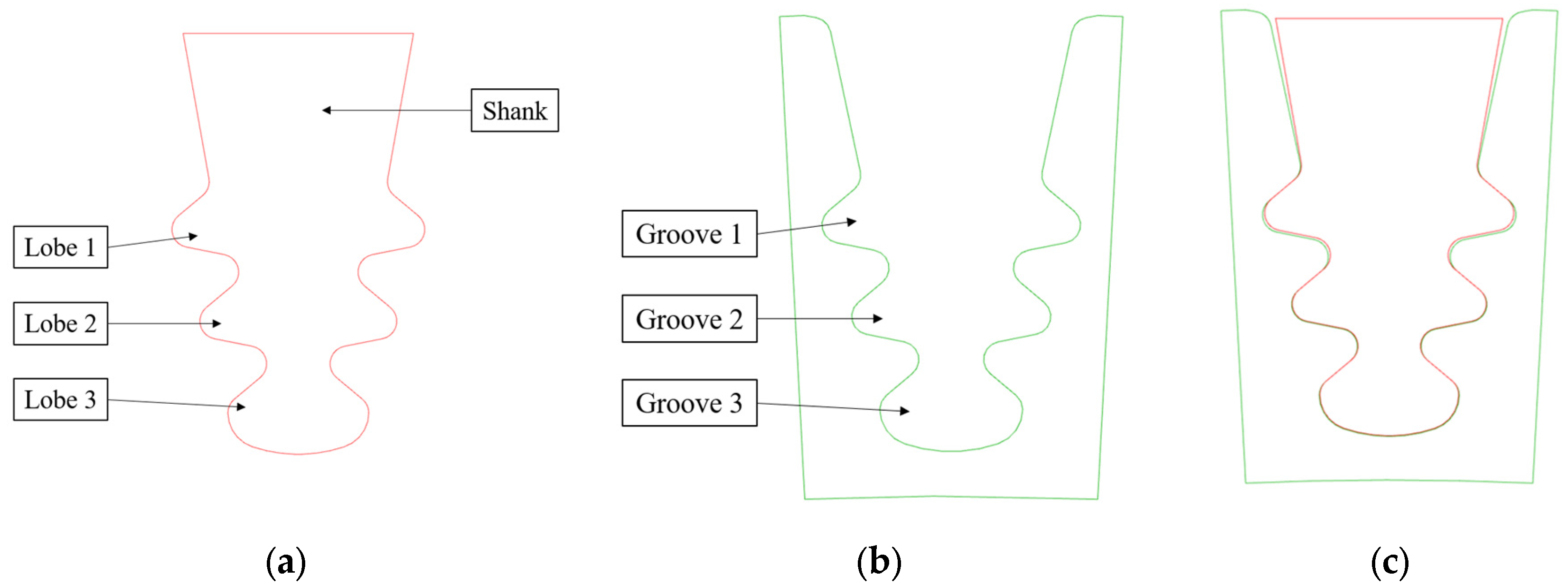
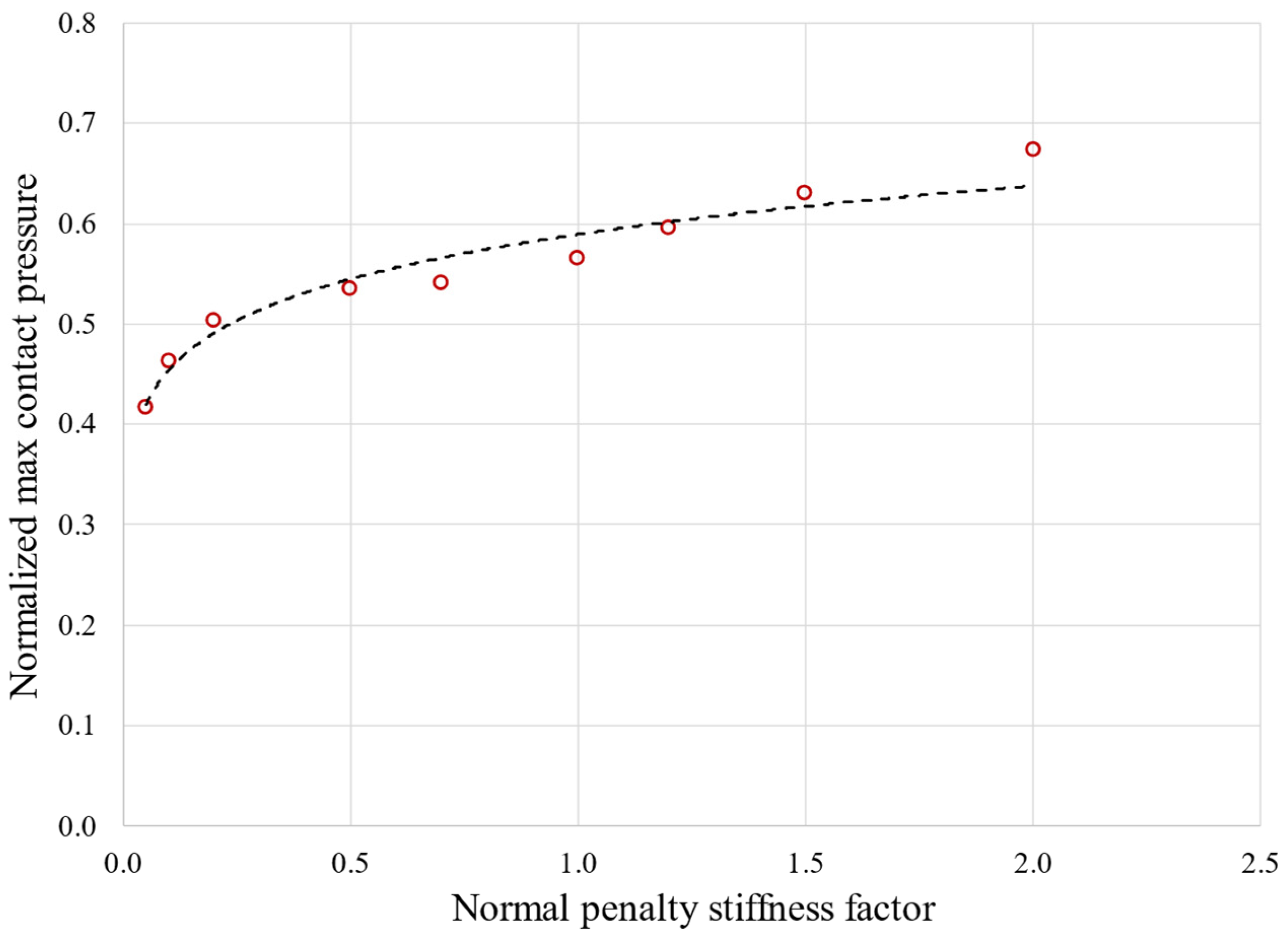



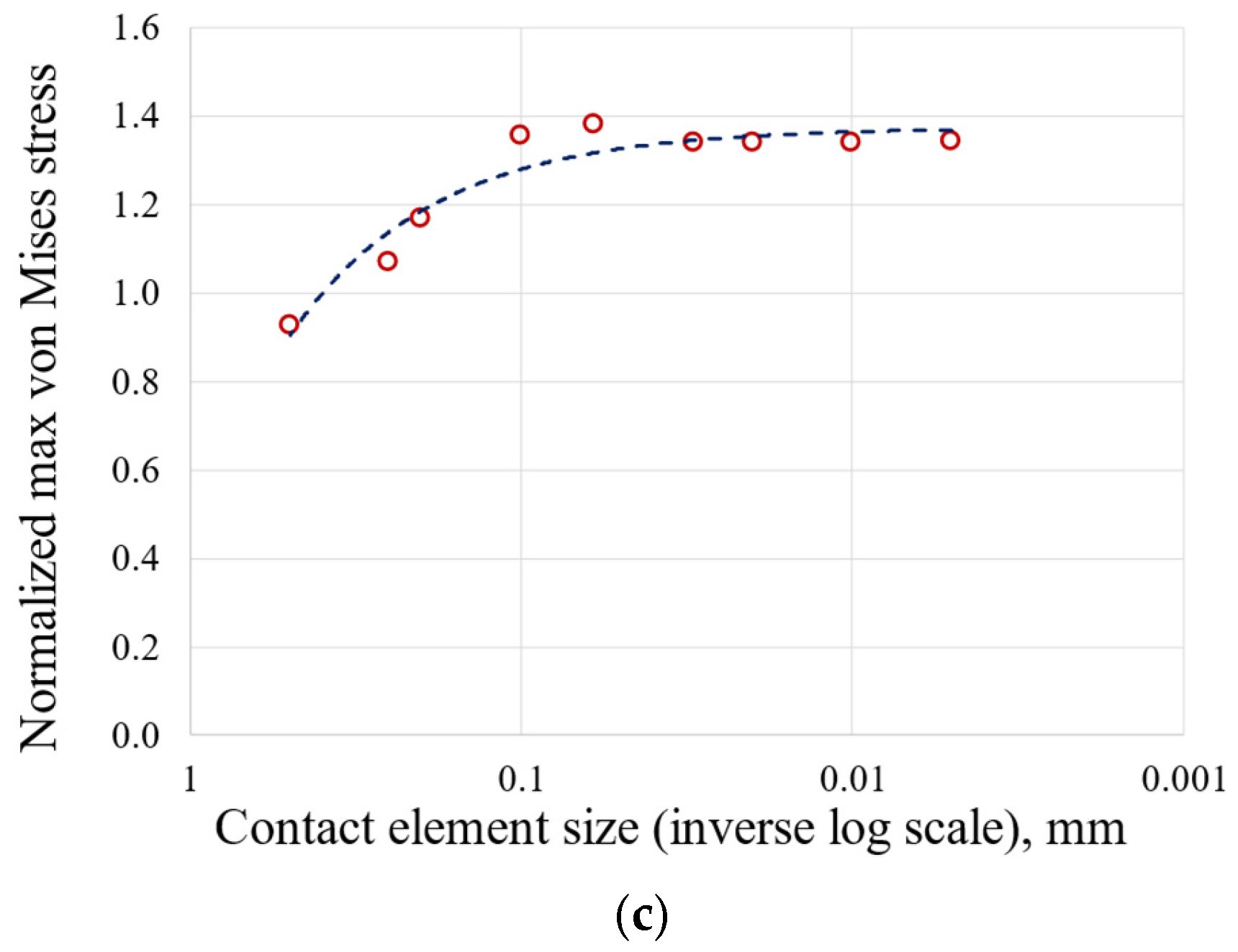

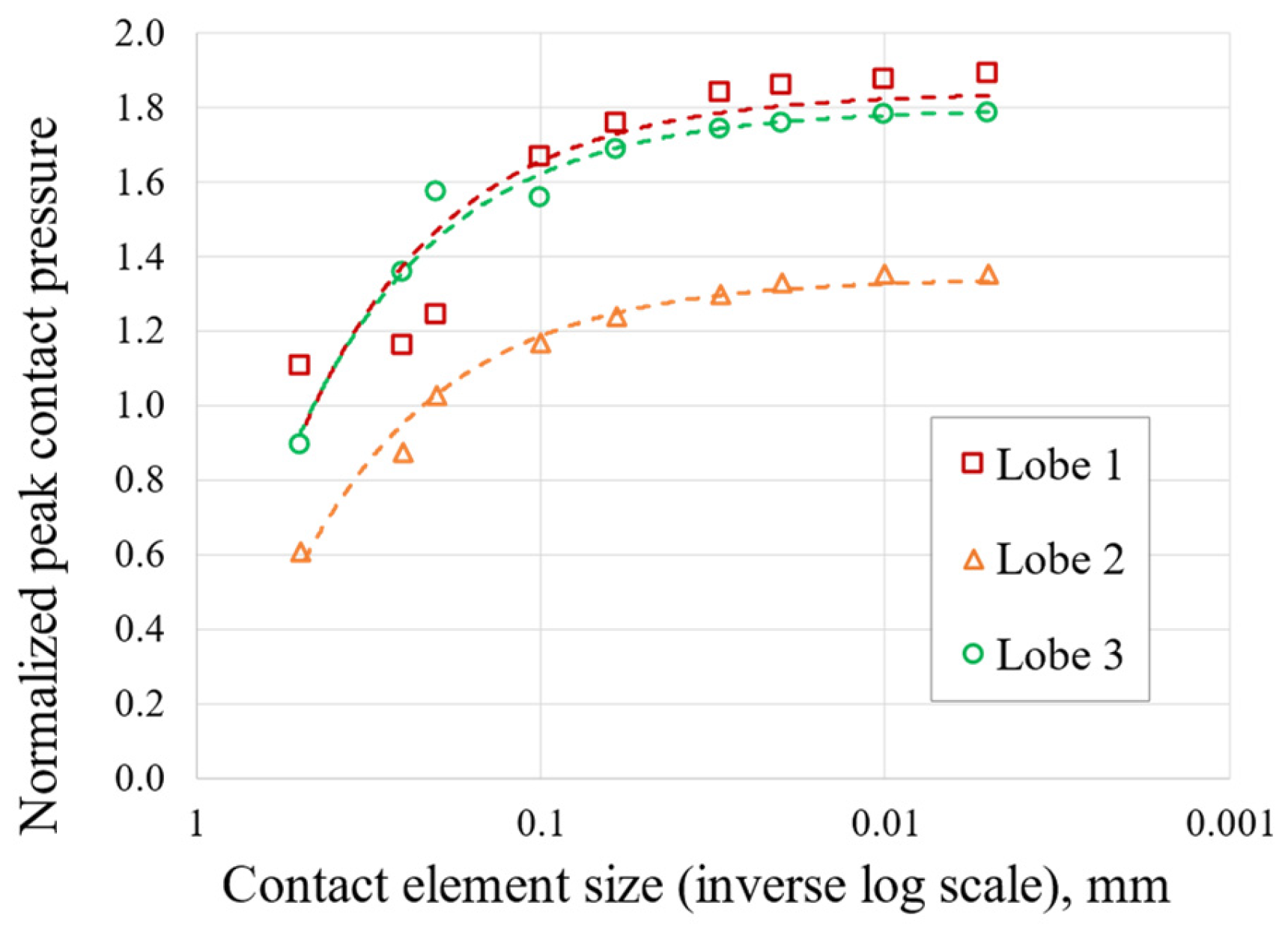
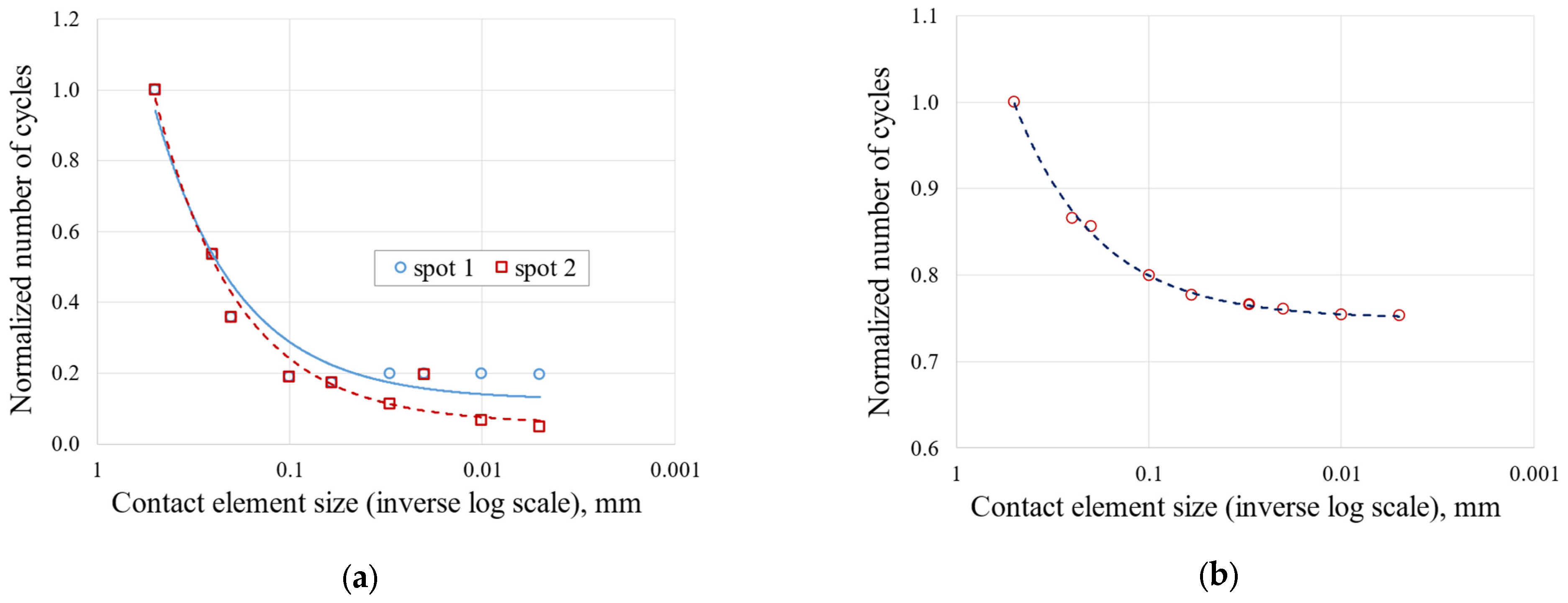



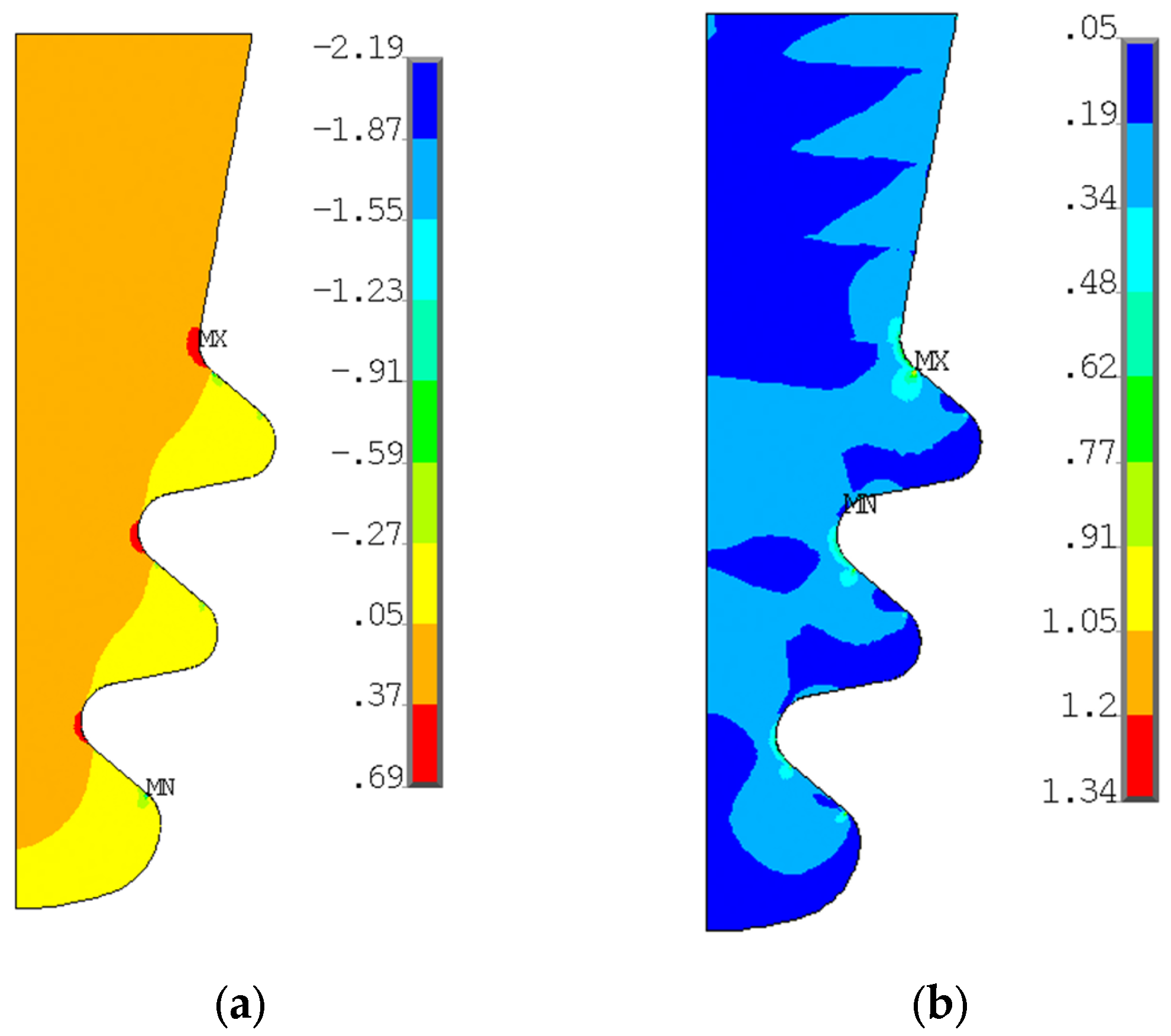
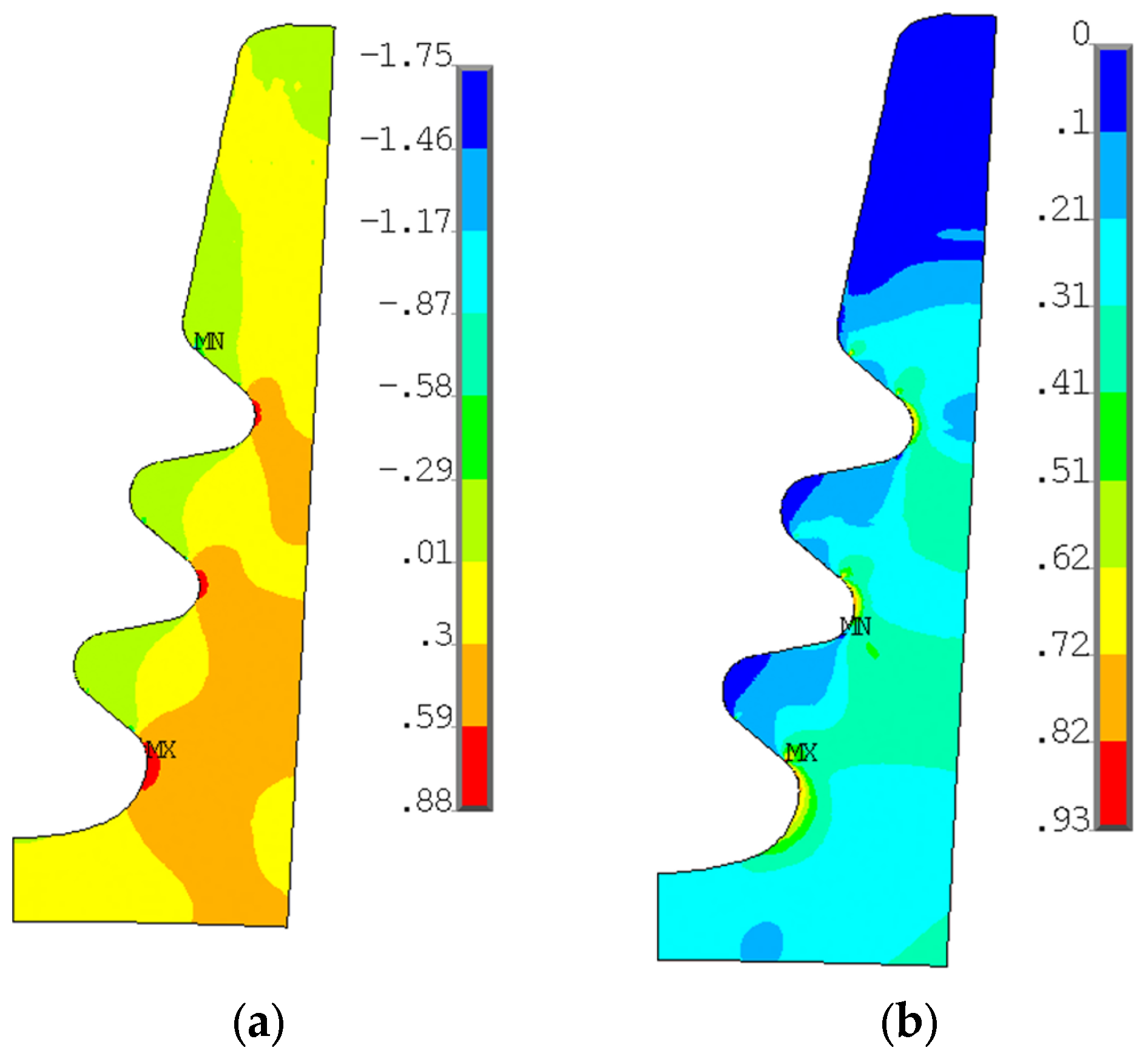
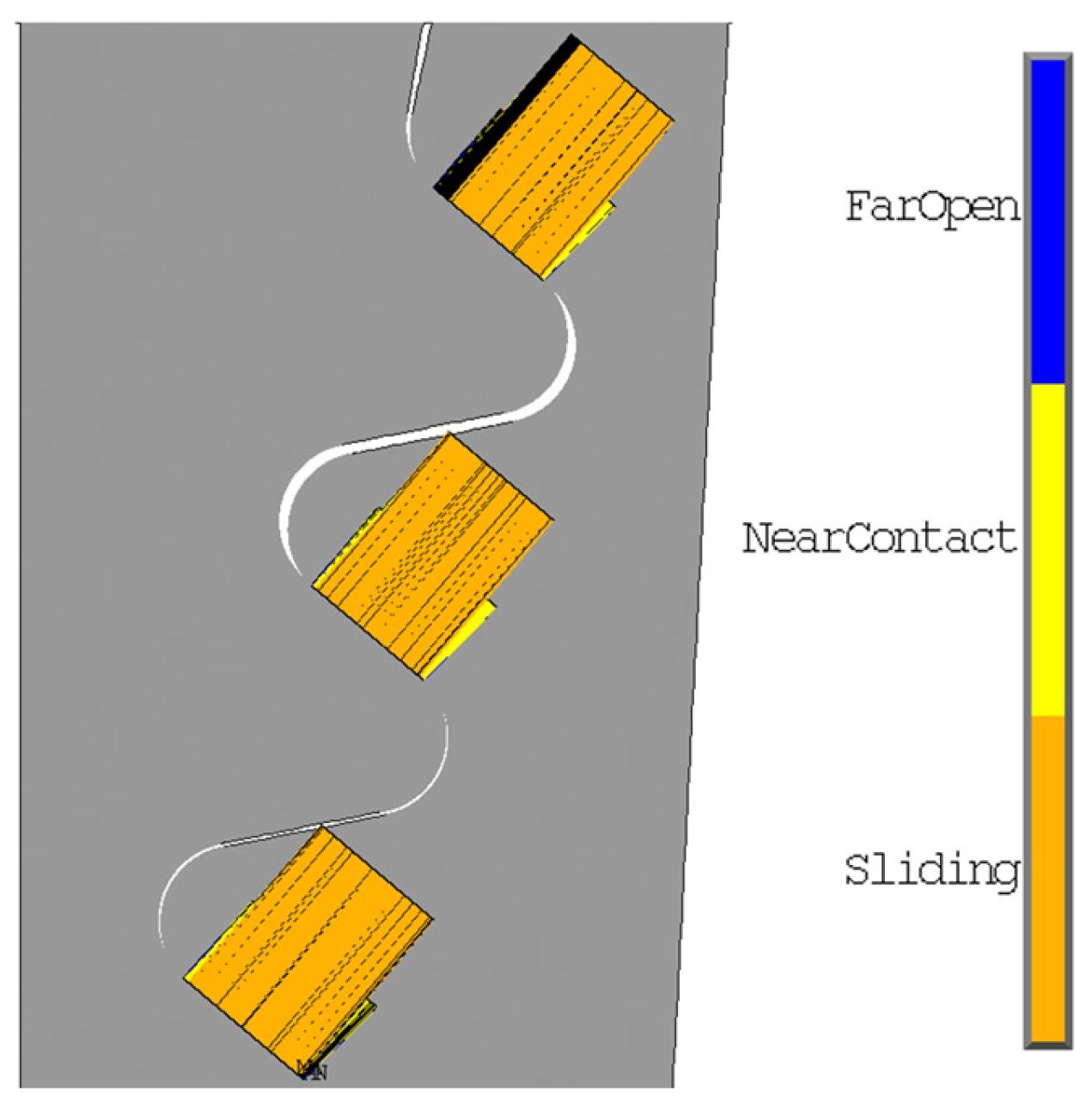

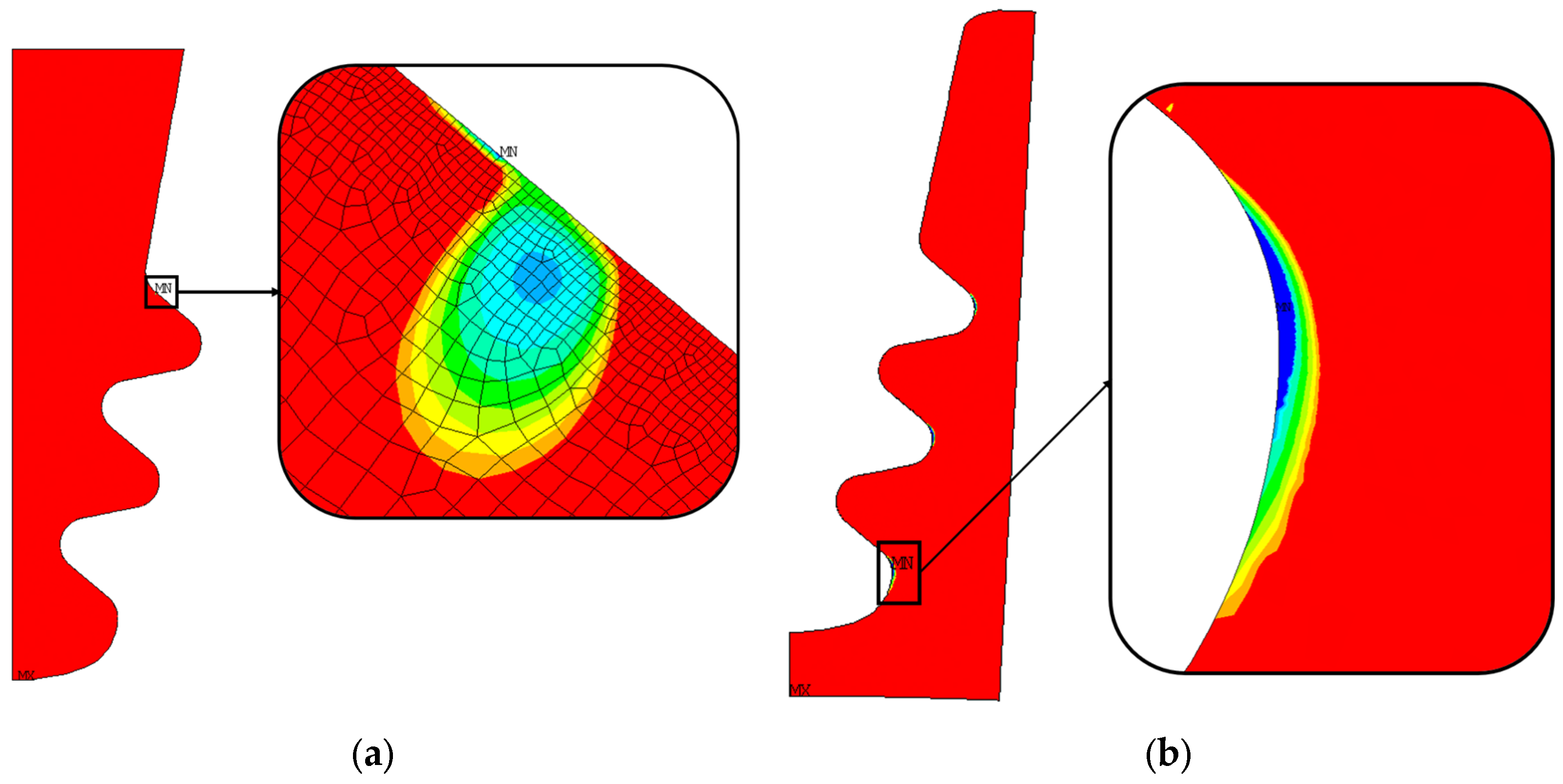
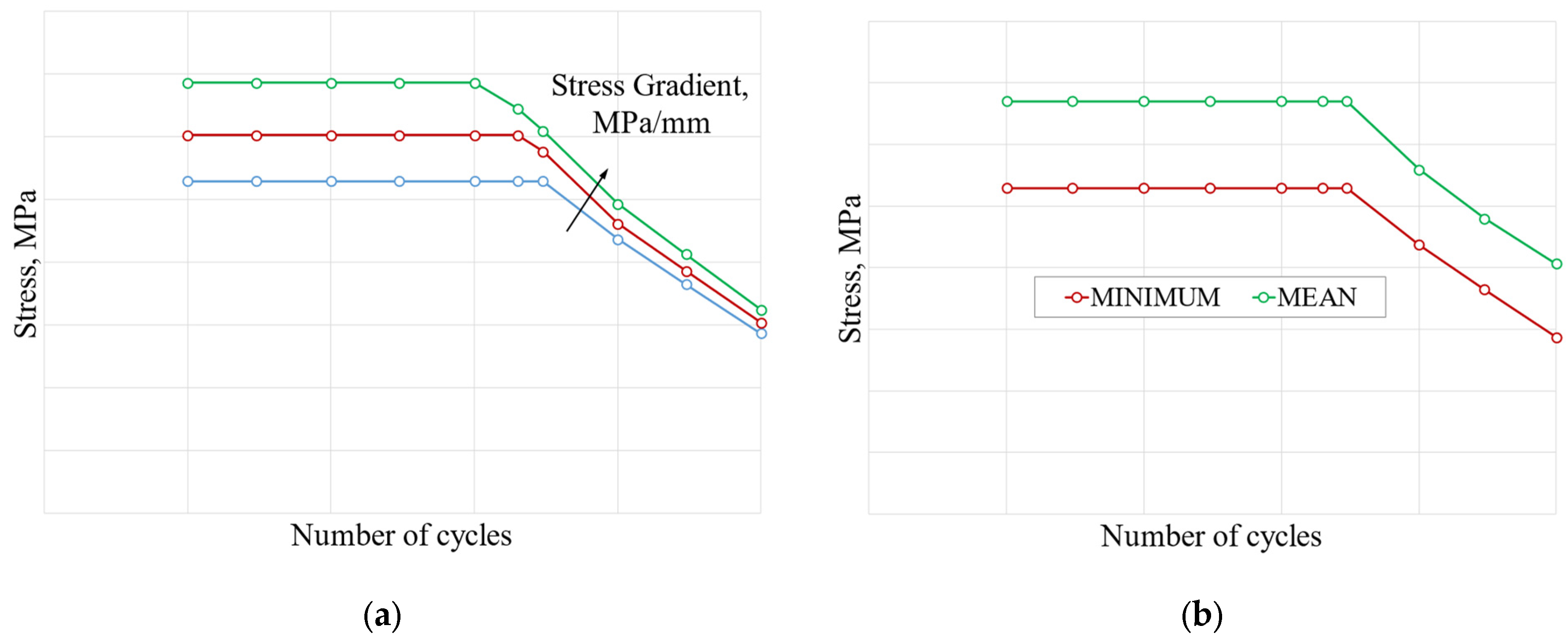

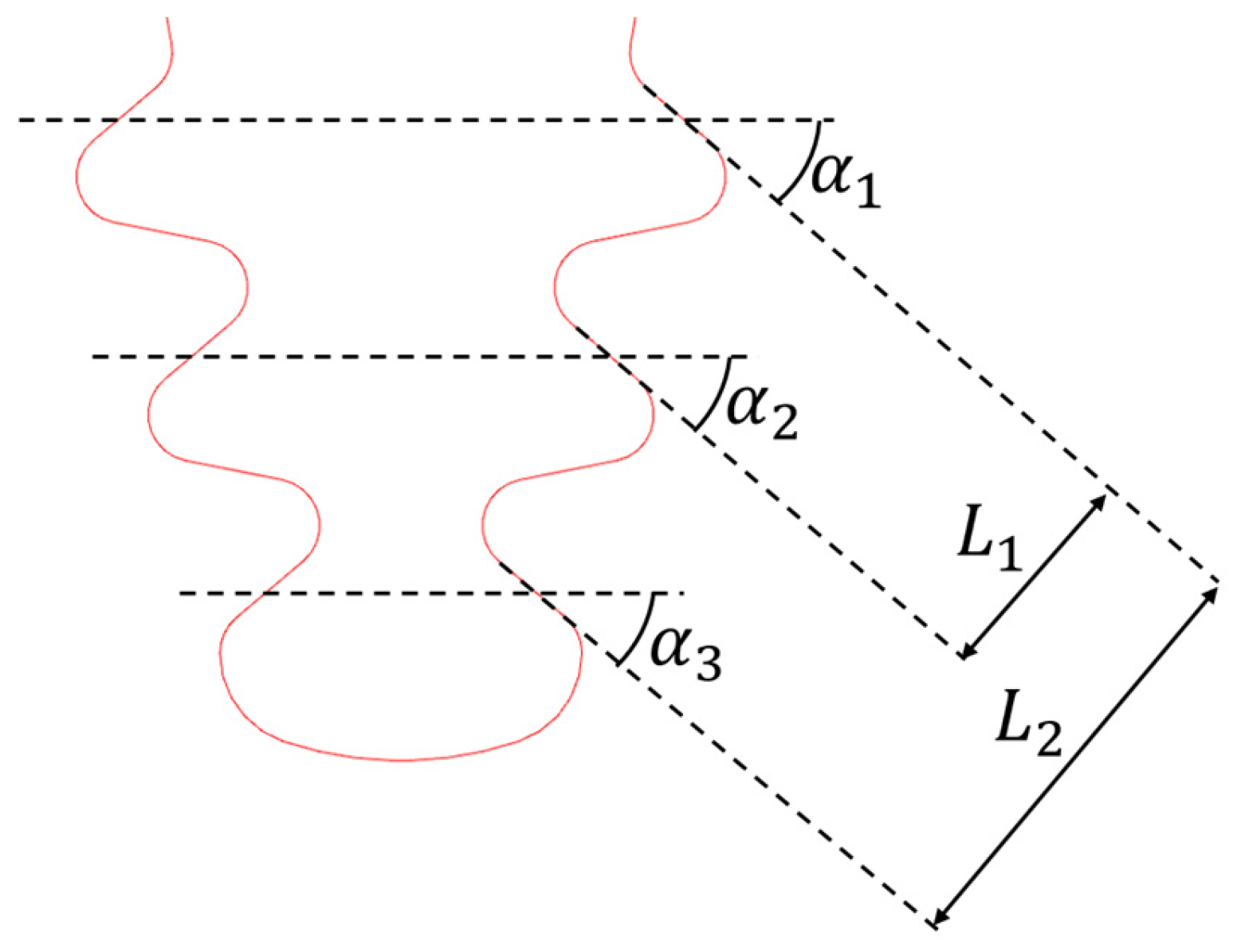
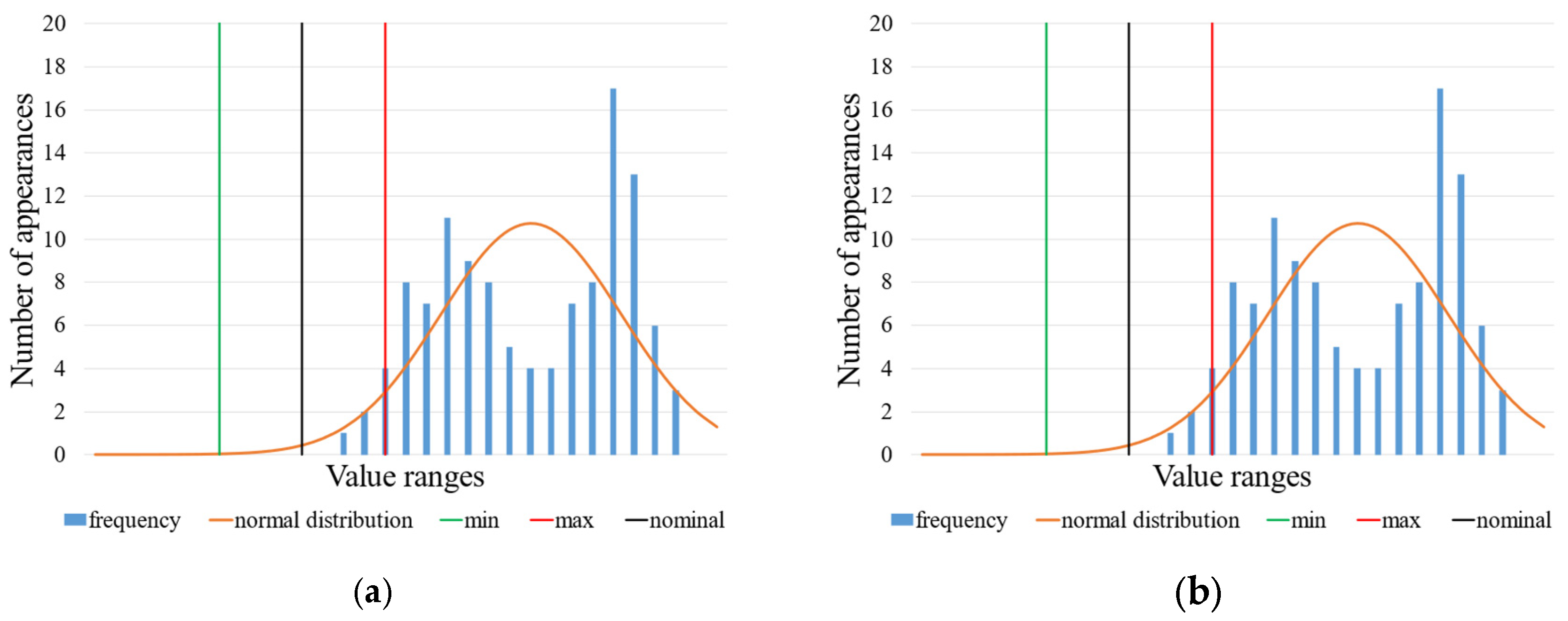

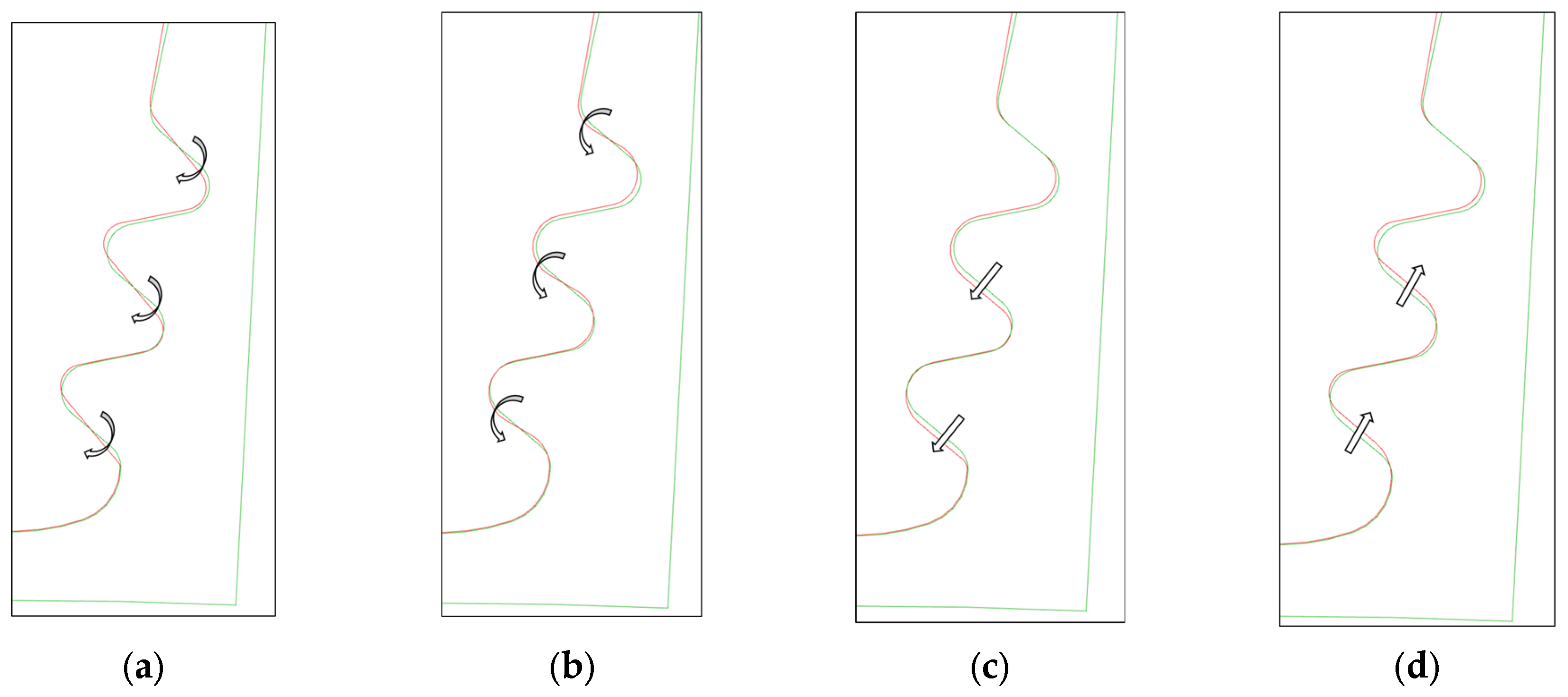
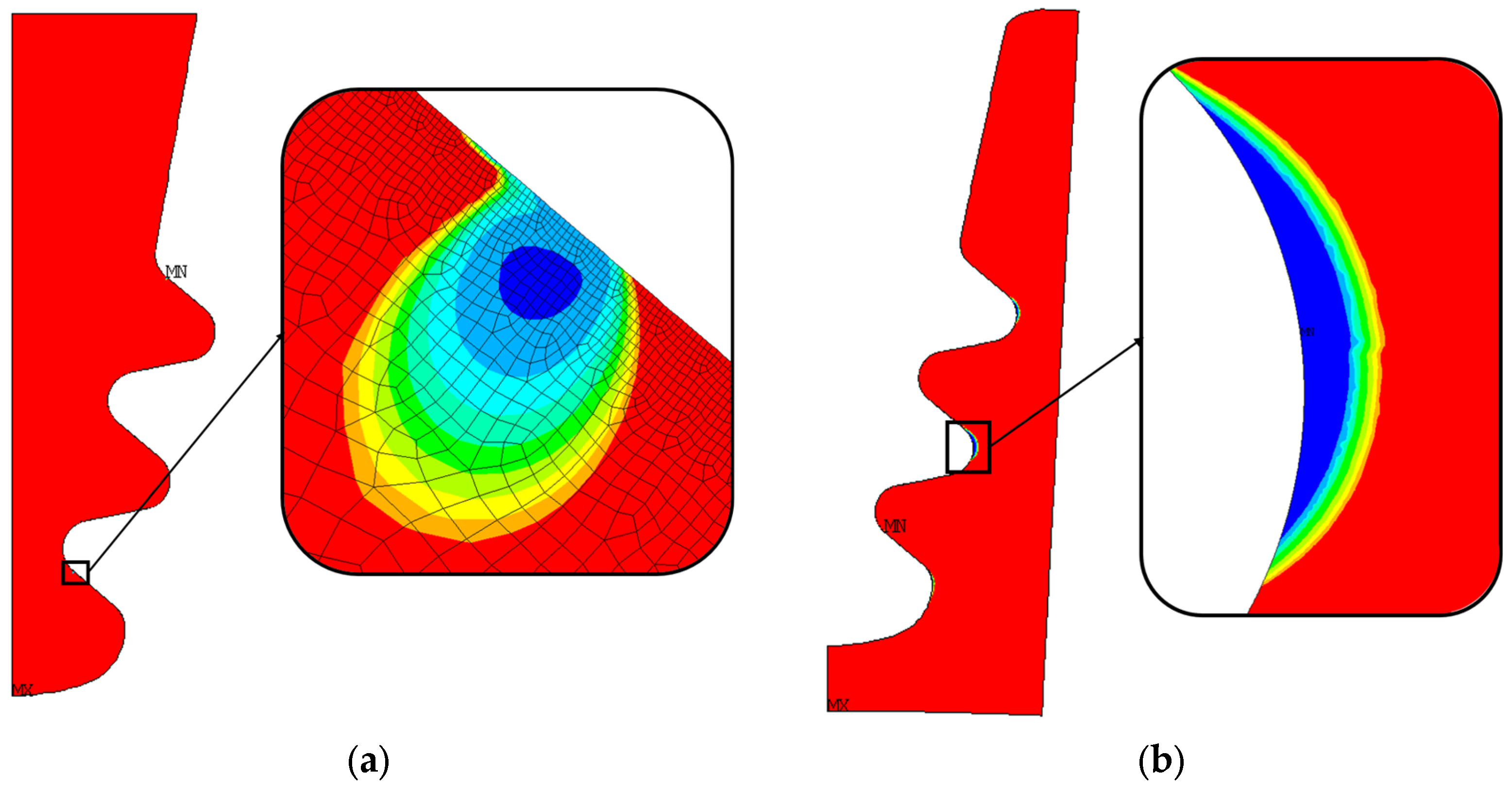


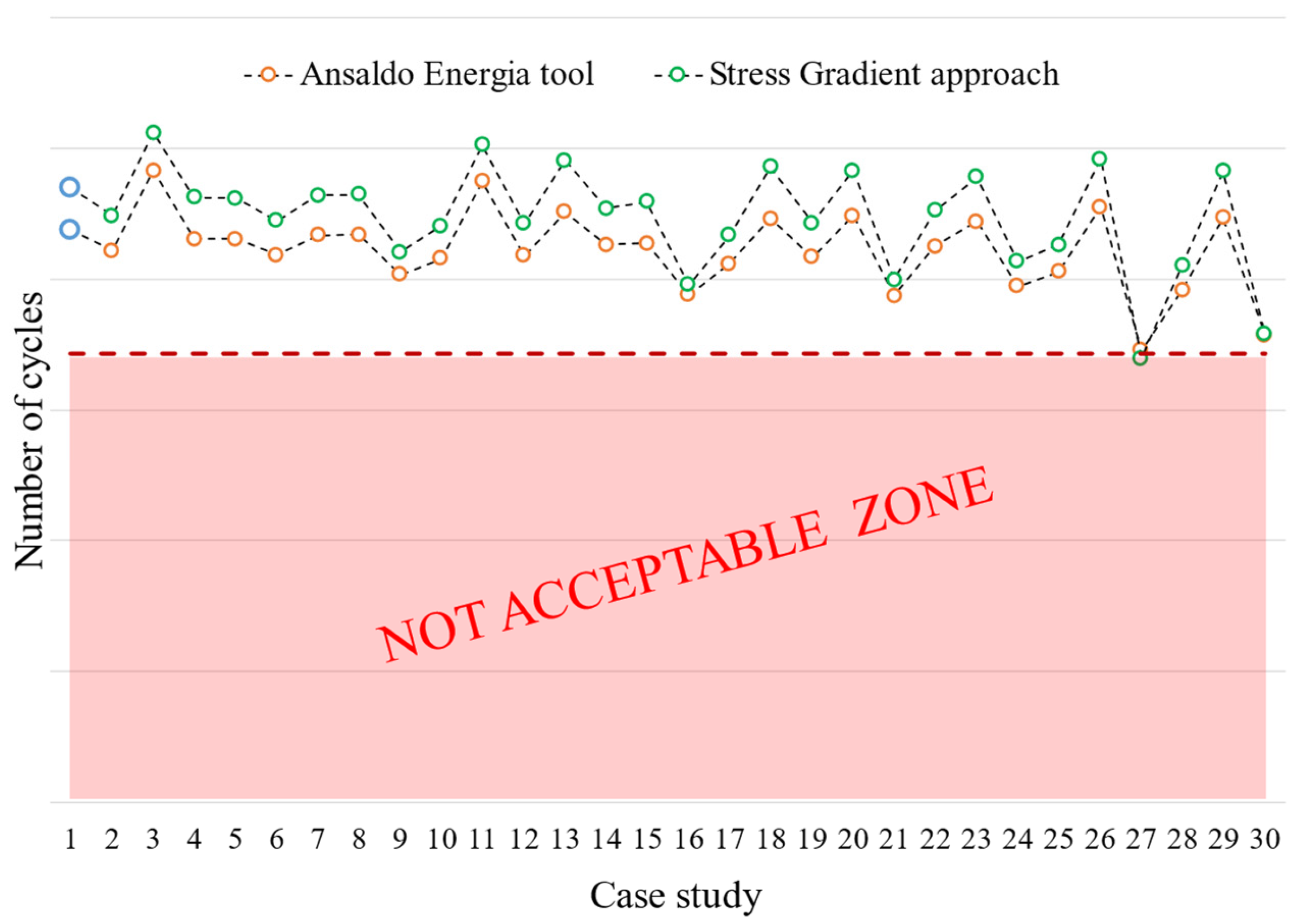
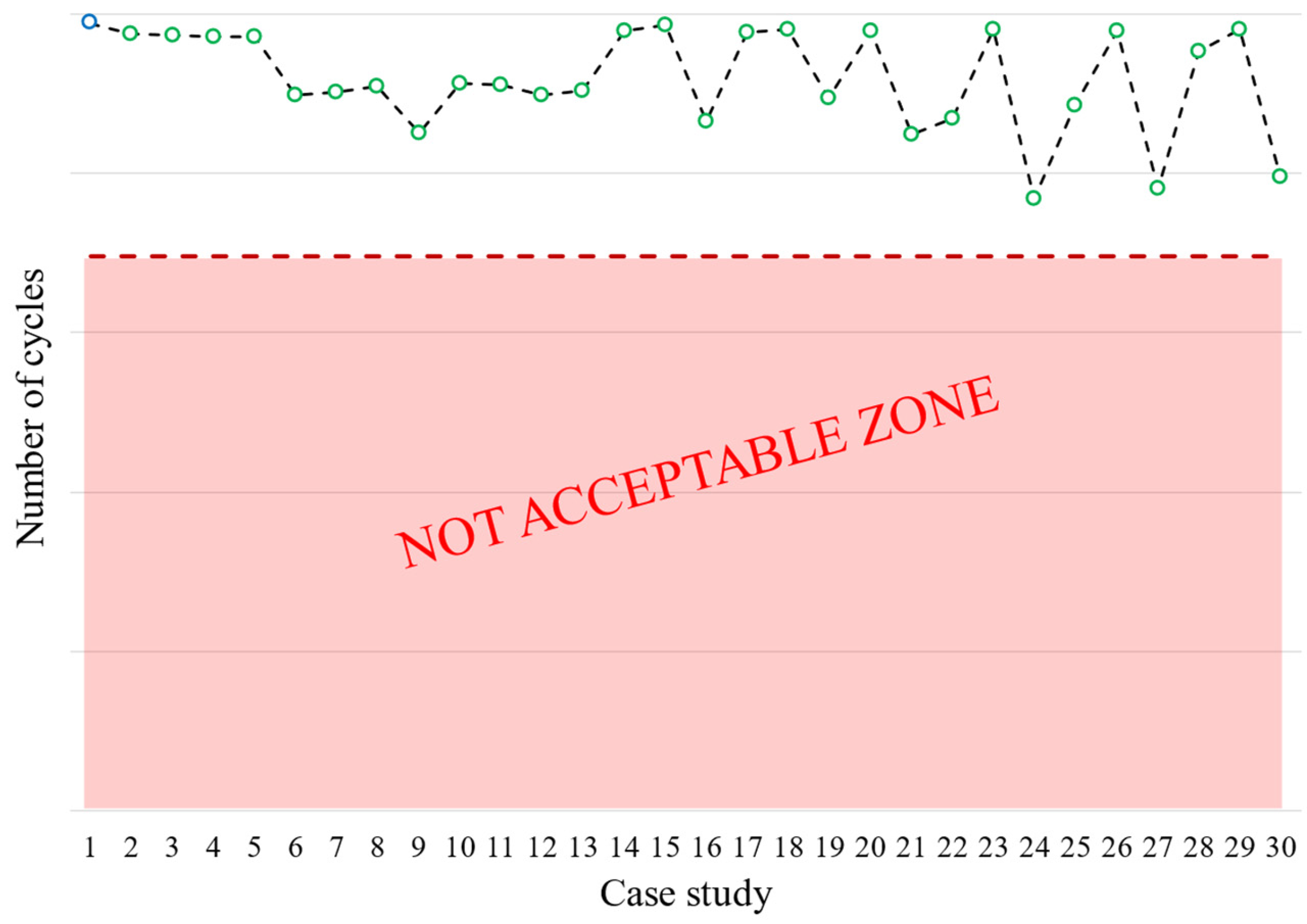
| Mesh Name | Number of Nodes | Blade Surface Element Size [mm] | Disc Surface Element Size [mm] | Blade Contacts Edges Element Size [mm] | Disc Target Edges Element Size [mm] |
|---|---|---|---|---|---|
| 70k | 70,203 | 0.5 | 0.5 | 0.5 | 0.5 |
| 270k | 276,696 | 0.25 | 0.25 | 0.25 | 0.25 |
| 43k | 43,384 | 1 | 1 | 0.2 | 0.2 |
| 79k | 78,557 | 1 | 1 | 0.1 | 0.1 |
| 125k | 125,334 | 1 | 1 | 0.06 | 0.06 |
| 240k | 241,340 | 1 | 1 | 0.03 | 0.03 |
| 355k | 354,821 | 1 | 1 | 0.02 | 0.02 |
| 693k | 692,708 | 1 | 1 | 0.01 | 0.01 |
| 1350k | 1,350,673 | 1 | 1 | 0.005 | 0.005 |
| Mesh Name | Maximum Radial Stress [-] | Minimum Radial Stress [-] | Maximum von Mises Stress [-] |
|---|---|---|---|
| 70k | 0.681 | −1.211 | 0.927 |
| 270k | 0.689 | −1.604 | 1.069 |
| 43k | 0.693 | −1.878 | 1.169 |
| 79k | 0.688 | −1.723 | 1.357 |
| 125k | 0.693 | −2.217 | 1.382 |
| 240k | 0.692 | −2.154 | 1.342 |
| 355k | 0.695 | −2.171 | 1.340 |
| 693k | 0.693 | −2.189 | 1.340 |
| 1350k | 0.693 | −2.206 | 1.345 |
| Mesh Name | Maximum Radial Stress [-] | Minimum Radial Stress [-] | Maximum von Mises Stress [-] |
|---|---|---|---|
| 70k | 0.934 | −1.358 | 0.852 |
| 270k | 0.932 | −1.537 | 1.047 |
| 43k | 0.935 | −1.598 | 1.142 |
| 79k | 0.935 | −1.962 | 1.214 |
| 125k | 0.936 | −2.032 | 1.240 |
| 240k | 0.936 | −2.091 | 1.176 |
| 355k | 0.936 | −2.093 | 1.170 |
| 693k | 0.936 | −2.106 | 1.173 |
| 1350k | 0.936 | −2.152 | 1.177 |
| Mesh Name | Lobe 1 Contact Pressure [-] | Lobe 2 Contact Pressure [-] | Lobe 3 Contact Pressure [-] |
|---|---|---|---|
| 70k | 1.104 | 0.608 | 0.894 |
| 270k | 1.160 | 0.875 | 1.356 |
| 43k | 1.245 | 1.029 | 1.571 |
| 79k | 1.667 | 1.167 | 1.557 |
| 125k | 1.758 | 1.241 | 1.685 |
| 240k | 1.840 | 1.300 | 1.741 |
| 355k | 1.859 | 1.329 | 1.756 |
| 693k | 1.874 | 1.353 | 1.779 |
| 1350k | 1.892 | 1.354 | 1.784 |
| Test | |||||
|---|---|---|---|---|---|
| 1 | nominal | nominal | nominal | nominal | nominal |
| 2 | upper tolerance | nominal | nominal | nominal | nominal |
| 3 | lower tolerance | nominal | nominal | nominal | nominal |
| 4 | nominal | upper tolerance | nominal | nominal | nominal |
| 5 | nominal | lower tolerance | nominal | nominal | nominal |
| 6 | nominal | out-of-tolerance | nominal | nominal | nominal |
| 7 | nominal | nominal | upper tolerance | nominal | nominal |
| 8 | nominal | nominal | lower tolerance | nominal | nominal |
| 9 | nominal | nominal | out-of-tolerance | nominal | nominal |
| 10 | upper tolerance | upper tolerance | nominal | nominal | nominal |
| 11 | lower tolerance | lower tolerance | nominal | nominal | nominal |
| 12 | upper tolerance | nominal | upper tolerance | nominal | nominal |
| 13 | lower tolerance | nominal | lower tolerance | nominal | nominal |
| 14 | nominal | upper tolerance | upper tolerance | nominal | nominal |
| 15 | nominal | lower tolerance | lower tolerance | nominal | nominal |
| 16 | nominal | out-of-tolerance | out-of-tolerance | nominal | nominal |
| 17 | upper tolerance | upper tolerance | upper tolerance | nominal | nominal |
| 18 | lower tolerance | lower tolerance | lower tolerance | nominal | nominal |
| 19 | nominal | nominal | nominal | upper tolerance | nominal |
| 20 | nominal | nominal | nominal | lower tolerance | nominal |
| 21 | nominal | nominal | nominal | out-of-tolerance | nominal |
| 22 | nominal | nominal | nominal | nominal | upper tolerance |
| 23 | nominal | nominal | nominal | nominal | lower tolerance |
| 24 | nominal | nominal | nominal | nominal | out-of-tolerance |
| 25 | nominal | nominal | nominal | upper tolerance | upper tolerance |
| 26 | nominal | nominal | nominal | lower tolerance | lower tolerance |
| 27 | nominal | nominal | nominal | out-of-tolerance | out-of-tolerance |
| 28 | upper tolerance | upper tolerance | upper tolerance | upper tolerance | upper tolerance |
| 29 | lower tolerance | lower tolerance | lower tolerance | lower tolerance | lower tolerance |
| 30 | nominal | out-of-tolerance | out-of-tolerance | out-of-tolerance | out-of-tolerance |
Disclaimer/Publisher’s Note: The statements, opinions and data contained in all publications are solely those of the individual author(s) and contributor(s) and not of MDPI and/or the editor(s). MDPI and/or the editor(s) disclaim responsibility for any injury to people or property resulting from any ideas, methods, instructions or products referred to in the content. |
© 2024 by the authors. Licensee MDPI, Basel, Switzerland. This article is an open access article distributed under the terms and conditions of the Creative Commons Attribution (CC BY) license (https://creativecommons.org/licenses/by/4.0/).
Share and Cite
Manzini, F.; Cesaretti, A.; Bessone, A.; Bagnera, F.; Botto, D. Lifing Assessment of Gas Turbine Blade Root Affected by Out-of-Tolerances. Materials 2024, 17, 4881. https://doi.org/10.3390/ma17194881
Manzini F, Cesaretti A, Bessone A, Bagnera F, Botto D. Lifing Assessment of Gas Turbine Blade Root Affected by Out-of-Tolerances. Materials. 2024; 17(19):4881. https://doi.org/10.3390/ma17194881
Chicago/Turabian StyleManzini, Federico, Alessandra Cesaretti, Andrea Bessone, Francesco Bagnera, and Daniele Botto. 2024. "Lifing Assessment of Gas Turbine Blade Root Affected by Out-of-Tolerances" Materials 17, no. 19: 4881. https://doi.org/10.3390/ma17194881
APA StyleManzini, F., Cesaretti, A., Bessone, A., Bagnera, F., & Botto, D. (2024). Lifing Assessment of Gas Turbine Blade Root Affected by Out-of-Tolerances. Materials, 17(19), 4881. https://doi.org/10.3390/ma17194881








